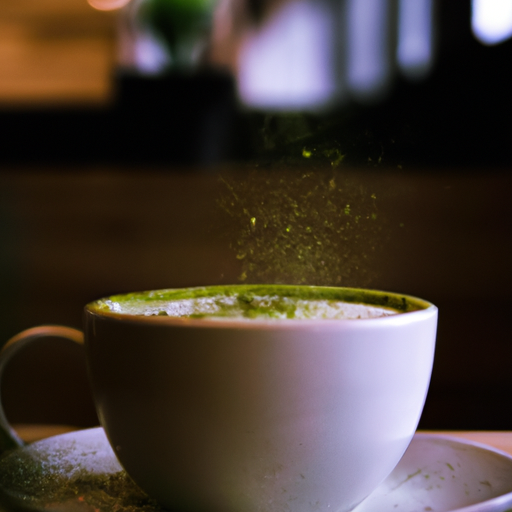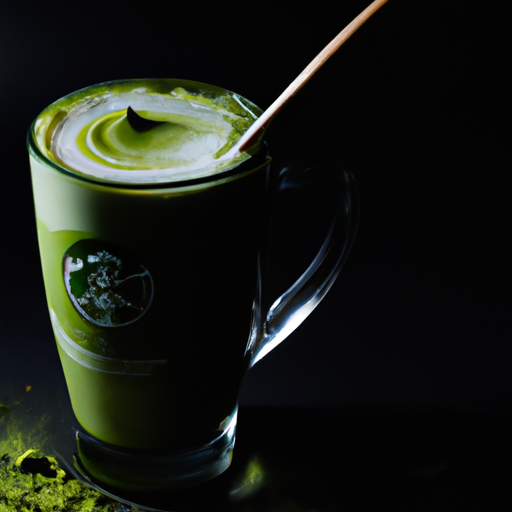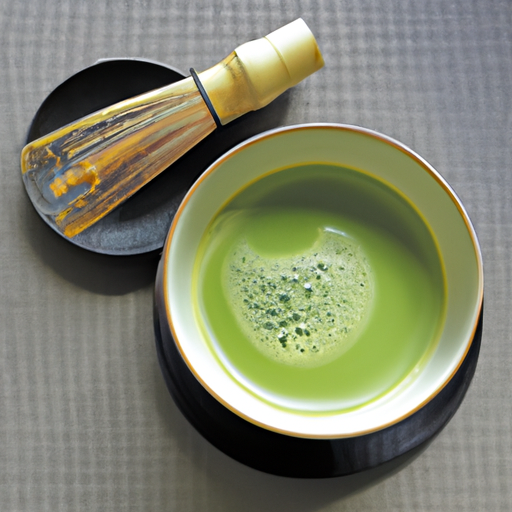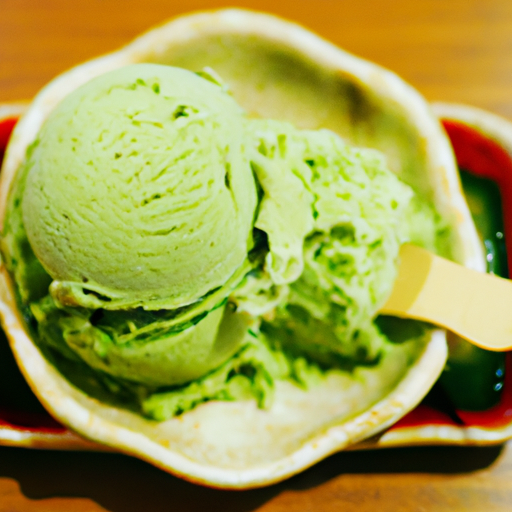The moment I experienced my initial taste of a matcha latte, the combination of earthy and mildly sweet tastes played across my palate. Its creamy texture wrapped around my mouth, creating a silky feeling that stayed with me well beyond the last sip. This pleasant encounter made me curious about how others perceive the flavor of a matcha latte.
A matcha latte is a unique drink that has gained popularity in recent years due to its health benefits and distinct flavor. Its vibrant green color and creamy texture make it a visually appealing drink that is hard to resist.
If you’re curious about what a matcha latte tastes like or want to learn more about this popular drink, keep reading to discover the taste profile, health benefits, and how to make a matcha latte at home.
Key Takeaways
- A matcha latte has a unique and distinct flavor that is both earthy and slightly bitter, yet balanced with natural sweetness.
- The use of high-quality matcha powder and properly heated milk is crucial to achieving a smooth and creamy texture.
- Matcha lattes offer numerous health benefits, including high levels of antioxidants, metabolism boosting effects, and calming properties.
- There are various ways to customize a matcha latte, including using different milk alternatives, sweeteners, and flavor additions like vanilla or cinnamon.
What is a Matcha Latte
You may have heard of a Matcha Latte before, it’s a delicious and creamy drink made with green tea powder and steamed milk. The origins of this popular drink can be traced back to Japan, where matcha has been consumed for centuries in tea ceremonies. However, it wasn’t until recent years that the matcha latte gained popularity in Western countries as a trendy and healthy beverage option.
Matcha powder is made by grinding green tea leaves into a fine powder. When mixed with steamed milk, it creates a rich and creamy texture that is both comforting and indulgent. The color of a matcha latte is a vibrant green, which is a testament to the high-quality matcha powder used to make it.
The popularity of matcha latte can be attributed to its unique taste and numerous health benefits. It has a slightly bitter and earthy flavor that is balanced out by the sweetness of the steamed milk. Matcha is also known for its high concentration of antioxidants and caffeine, which makes it a healthier alternative to traditional coffee drinks.
With all of these benefits, it’s no wonder that the matcha latte has become a go-to beverage for health-conscious individuals. As for the taste profile of matcha latte, it’s a balance of bitter and sweet notes that creates a unique and delicious flavor. But don’t just take my word for it, try a matcha latte for yourself and experience the creamy, indulgent, and healthy goodness that has taken the world by storm.
The Taste Profile of Matcha Latte
Indulging in a matcha latte is like taking a sip of creamy green goodness that dances on your taste buds like a lively tango. The taste of matcha latte is unique and distinct from other types of lattes, owing to the use of matcha powder as the key ingredient.
The taste of matcha latte is a balance of natural sweetness and slight bitterness, which makes it a perfect drink for those who enjoy a refreshing and light taste. In terms of taste comparisons, matcha latte is often compared to green tea latte, but the former has a more pronounced and intense flavor.
The matcha powder used in matcha latte has a grassy and earthy taste, which is complemented by the richness of the milk. This combination creates a creamy, smooth, and frothy texture that is appealing to the palate. Cultural significance also plays a role in the taste profile of matcha latte.
Matcha is a traditional Japanese tea that has been consumed for centuries. In Japan, matcha is considered a symbol of hospitality, and its preparation is considered an art form. The cultural significance of matcha is reflected in the taste of matcha latte, which has a delicate and refined flavor that is reminiscent of Japanese tea ceremonies.
Indulging in a matcha latte not only satisfies your taste buds, but it also offers numerous health benefits. From boosting metabolism to detoxifying the body, matcha latte is a drink that does wonders for your body.
Health Benefits of Matcha Latte
I love drinking matcha latte not just for its delicious taste, but also for its health benefits.
Matcha latte is high in antioxidants, which helps protect the body from free radicals and reduce the risk of chronic diseases. It also boosts metabolism, which can aid in weight loss and improve energy levels.
Additionally, matcha latte has calming effects due to its high content of L-theanine, which promotes relaxation and reduces anxiety.
High in Antioxidants
Feeling like you need a health boost? Sipping on a matcha latte can provide you with a high dose of antioxidants to help fight off harmful free radicals in your body. Matcha is grown in Japan, and some of the best growing regions include Uji, Nishio, and Shizuoka.
The production process involves shading the tea plants for several weeks before harvest, which increases the chlorophyll content and gives the tea leaves a vibrant green color. The leaves are then ground into a fine powder, which is whisked with water to make matcha.
Matcha is rich in antioxidants called catechins, particularly epigallocatechin gallate (EGCG). Antioxidants are molecules that help protect the body from damage caused by harmful free radicals. Matcha contains more antioxidants than other types of green tea because the whole leaf is consumed, rather than just the brewed water.
In addition to antioxidants, matcha also contains caffeine and L-theanine, which work together to provide a calm and focused energy boost. This combination is what sets matcha apart from other caffeinated beverages. Now, let’s talk about another benefit of matcha latte – it boosts metabolism.
Boosts Metabolism
Get ready to rev up your metabolism with a matcha latte – it’s the perfect way to give your body a natural energy boost and burn more calories throughout the day! Matcha is loaded with catechins, a type of antioxidant that has been shown to increase metabolism and promote weight loss.
When you drink matcha, you’re not only getting the energy boost you need to power through your day, but you’re also giving your metabolism a kickstart that can help you burn more calories and shed those extra pounds. The catechins in matcha work by increasing thermogenesis, which is the process by which your body burns calories to produce heat.
This means that when you drink matcha, your body is working harder to burn calories, even when you are at rest. In fact, studies have shown that drinking matcha can increase your metabolism by up to 40%, making it an excellent choice for anyone looking to lose weight or maintain a healthy weight. So, if you’re looking for a natural way to boost your metabolism and promote weight loss, look no further than a delicious and refreshing matcha latte!
Speaking of natural ways to improve your health, let’s talk about the calming effects of matcha.
Calming Effects
Experience a sense of relaxation and tranquility with matcha’s calming effects. It can help reduce stress and anxiety levels. Here are a few reasons why matcha is known for its calming effects:
- L-theanine: A unique amino acid found in matcha that promotes relaxation without causing drowsiness.
- Antioxidants: Matcha is packed with antioxidants that reduce inflammation and promote a sense of well-being.
- Ritualistic preparation: The process of making matcha can be meditative and calming in and of itself.
- Mindfulness: Drinking matcha mindfully, focusing on the taste and aroma, can help bring a sense of calm and clarity.
But matcha’s benefits extend beyond just calming effects. It also provides a boost in focus and energy, making it a great alternative to coffee.
In the next section, we’ll explore how to make a matcha latte at home.
How to Make a Matcha Latte at Home
I love making matcha lattes at home because it’s easy and I can control the ingredients.
To make a matcha latte, you’ll need matcha powder, milk (dairy or non-dairy), sweetener (optional), and hot water. The process involves whisking the matcha powder with hot water, frothing the milk, and combining the two.
Here are some tips for perfecting your matcha latte brew: use high-quality matcha powder, heat the milk properly, and adjust the sweetness to your preference.
Ingredients Needed
To make a delicious matcha latte, you’ll need matcha powder, milk, sweetener, and a whisk. But there are also other ingredients you can use to create different variations of this popular drink.
For instance, you can add vanilla extract, cinnamon, or even coconut milk to your matcha latte for a unique flavor profile. For those who don’t want to use dairy milk, you can substitute with almond, soy, or oat milk to make it vegan-friendly.
When selecting your matcha powder, it’s important to choose a high-quality brand that’s organic and free of additives. You want to make sure you’re getting the full benefits of matcha, which is high in antioxidants and provides a natural energy boost.
Once you have all the ingredients, it’s time to move on to the step-by-step process of making a delicious matcha latte.
Step-by-Step Process
Now that we’ve got all the ingredients we need for our matcha latte, it’s time to get brewing! First, I like to start by whisking the matcha powder with a small amount of hot water in a bowl until it becomes a smooth paste. This helps to prevent clumps from forming later on.
Next, I heat up my milk alternative of choice (such as almond or oat milk) and pour it into the bowl with the matcha paste. I give it a good whisk until everything is well combined and frothy. The matcha flavor is unique – it’s earthy and slightly bitter, but also has a sweetness to it that balances it out. The milk alternative helps to mellow out the bitterness and create a creamy, comforting drink.
Now that our matcha latte is ready, let’s move on to some tips for perfecting your brew.
Tips for Perfecting Your Brew
If you want to take your matcha latte game to the next level, be sure to experiment with different milk alternatives and find your favorite, as it can make all the difference in creating a drink that is out-of-this-world delicious. While traditional matcha lattes are typically made with cow’s milk, there are a variety of non-dairy milk options that can bring a unique flavor profile to your latte.
Flavor experimentation is key when it comes to creating the perfect matcha latte. To help you get started, here is a table outlining some popular milk alternatives and their taste profiles:
| Milk Alternative | Taste Profile |
|---|---|
| Almond Milk | Nutty, slightly sweet |
| Coconut Milk | Creamy, slightly sweet |
| Soy Milk | Neutral, slightly sweet |
| Oat Milk | Creamy, slightly sweet |
By trying out different milk alternatives, you can create a matcha latte that perfectly suits your taste preferences. Once you’ve found your favorite combination, you can move on to exploring popular variations of matcha latte, such as matcha frappuccinos or matcha lattes with added flavors like vanilla or caramel.
Popular Variations of Matcha Latte
Matcha latte lovers can’t get enough of the popular variations, like adding honey or coconut milk, that enhance the flavor of this delicious drink. Some people prefer their matcha latte hot, while others enjoy it iced. Milk is another variable that can alter the taste and texture of the latte, with some opting for the creaminess of dairy milk while others choose non-dairy alternatives like almond or oat milk. Sweeteners, such as agave or maple syrup, can also be added to balance out the bitterness of the matcha powder.
For those who want to take it to the next level, flavored matcha lattes are a must-try. Popular flavors include vanilla, lavender, and rose. Additionally, matcha latte art has become a trend in recent years, with baristas using different techniques and designs to create beautiful and intricate patterns on top of the latte foam. Whether it’s a simple heart or an intricate flower, matcha latte art adds an extra touch of elegance to this beloved beverage.
If you’re wondering where to find the best matcha latte, there are plenty of options available. Many coffee shops and cafes now offer this drink on their menu, but it’s important to do your research and read reviews before choosing a spot. It’s also worth considering making your own matcha latte at home, as this allows you to customize the drink to your liking and experiment with different variations.
With a little practice and patience, you can create a matcha latte that’s even better than your favorite coffee shop’s version.
Where to Find the Best Matcha Latte
Finding the best matcha latte can be quite a task, especially when you’re a coffee enthusiast like me. However, after conducting thorough research and taste comparisons, I’ve come to the conclusion that the best cafes for matcha lattes are often the ones that specialize in Japanese cuisine.
These cafes tend to use high-quality matcha powder, which results in a rich and authentic taste that is hard to find elsewhere. One of my favorite cafes for matcha lattes is a hidden gem located in the heart of the city. This cozy cafe not only offers a warm and inviting atmosphere but also serves the most delicious matcha latte I’ve ever had.
The latte is perfectly balanced, with just the right amount of sweetness and bitterness, making it a delightful treat for any matcha lover. If you’re on the hunt for the perfect matcha latte, don’t be afraid to venture out and try different cafes.
You may be surprised to find that some of the best matcha lattes come from unexpected places. And who knows, you might even stumble upon a new favorite spot that you never knew existed. When it comes to matcha latte and Japanese culture, there is much to explore.
From the traditional tea ceremony to the modern interpretation of this delicious beverage, the influence of Japanese culture can be seen and tasted in every sip. So, let’s dive deeper into the fascinating world of matcha and discover the beauty and complexity of this beloved drink.
Matcha Latte and Japanese Culture
I’ve always been fascinated by the rich cultural heritage of Japan, especially when it comes to their tea ceremonies. The serene ritual of preparing and serving tea, especially matcha, has been an integral part of Japanese culture for centuries.
Today, matcha has become a trendy ingredient in the culinary world, with chefs and food enthusiasts experimenting with new ways to incorporate it into their dishes.
Traditional Tea Ceremonies
Experiencing the intricate movements and rituals of a traditional tea ceremony can transport you to a world of tranquility and mindfulness. The tea ceremony, also known as chanoyu, has been a significant part of Japanese culture for centuries. It is a practice that involves not only drinking tea but also observing etiquette and socializing with other guests.
One of the essential aspects of the tea ceremony is its etiquette. Guests are expected to follow specific rules, such as bowing upon entering the tea room and walking in a particular way. The tea ceremony also emphasizes the importance of mindfulness, attention to detail, and respect for others. These values are deeply ingrained in Japanese culture and have been passed down through generations. The tea ceremony’s cultural significance is evident in how it has influenced other areas of Japanese art and culture, such as pottery and flower arrangement.
As the tea ceremony evolved over time, so did the use of matcha. Today, matcha has become a popular ingredient in various food and beverage items, such as matcha lattes and matcha-flavored desserts. This modern matcha culture has taken on a life of its own, with many people enjoying matcha for its unique flavor and health benefits. However, it is essential to remember the cultural significance of matcha and the tea ceremony and to approach it with respect and mindfulness.
Modern Matcha Culture
While the traditional tea ceremony emphasizes mindfulness and respect, the modern matcha culture often prioritizes convenience and novelty. Matcha cafes have popped up all over the world, offering matcha-infused drinks and desserts, such as matcha lattes, matcha ice cream, and matcha smoothies. These cafes provide a trendy and Instagram-worthy atmosphere, appealing to the younger generation.
Moreover, matcha has also become a fashion statement. From matcha-colored clothing to matcha-themed accessories, it’s evident that matcha has transcended from a mere beverage to a lifestyle. With matcha’s rising popularity, it’s no surprise that it has become a significant culinary ingredient in various dishes, from savory to sweet.
As matcha continues to take the world by storm, let’s delve deeper into its versatility as a culinary ingredient.
Matcha as a Culinary Ingredient
As I was exploring modern matcha culture, I discovered that matcha is not only consumed as a beverage but also used as a culinary ingredient. Matcha desserts have become increasingly popular in recent years, with chefs incorporating the ingredient into everything from cakes to ice cream. The earthy and slightly bitter flavor of matcha adds a unique complexity to sweet treats, making them stand out from traditional desserts.
But matcha doesn’t just belong in the realm of sweets. It can also be used in savory dishes, adding a subtle depth of flavor to dishes like pasta, soup, and even roasted vegetables. The versatility of matcha as an ingredient is truly remarkable, and it’s exciting to see chefs and home cooks alike experimenting with its potential in the kitchen.
With matcha’s growing popularity in culinary applications, it’s no surprise that it has also made its way into the world of beverages. One such beverage is the matcha latte, which has become a popular staple in coffee shops and cafes. But what exactly does a matcha latte taste like? Read on to find out.
Matcha Latte in Popular Culture
I can’t help but notice how matcha latte has become a trending beverage in recent years. It’s not just a drink, it’s a cultural phenomenon that has inspired many recipes and products.
From matcha-infused desserts to matcha face masks, the craze for this vibrant green tea seems to be unstoppable. And who can blame them? Even celebrities have jumped on the matcha bandwagon, endorsing its health benefits and unique taste.
Matcha as a Trending Beverage
Matcha latte, with its vibrant green color and earthy aroma, has become a popular beverage choice among health-conscious individuals. As a result, the matcha industry has experienced tremendous growth in recent years. Matcha farming practices have evolved to meet the demand for high-quality matcha, resulting in a wide range of grades and flavors.
To better understand the matcha industry’s growth, let’s take a look at the following table:
| Year | Global Matcha Market Size (in USD) | Expected Growth Rate |
|---|---|---|
| 2016 | 1.63 billion | 8.2% |
| 2017 | 1.73 billion | 6.1% |
| 2018 | 1.80 billion | 4.0% |
| 2019 | 1.92 billion | 6.7% |
| 2020 | 2.03 billion | 5.7% |
As you can see, the matcha market has been steadily growing over the past few years, with an expected growth rate of 5.7% in 2020. This growth is driven by the increasing popularity of matcha as a healthy and versatile ingredient. From matcha lattes to matcha ice cream, there are countless ways to enjoy this delicious and nutritious ingredient.
In the next section, we will explore some matcha inspired recipes that are sure to delight your taste buds.
Matcha Inspired Recipes
As I mentioned earlier, matcha has become a popular beverage in recent years. But its uses don’t stop there. Matcha is also a great ingredient for desserts and smoothies. I love experimenting with matcha in the kitchen and finding new ways to incorporate it into my meals.
One of my favorite matcha-inspired recipes is a matcha latte cheesecake. The creamy cheesecake filling is infused with matcha powder and is set on top of a graham cracker crust. It’s the perfect balance of sweet and earthy flavors.
I also enjoy making matcha smoothies for breakfast. I blend together matcha powder, almond milk, banana, and spinach for a refreshing and energizing start to my day.
Moving on to the next topic, celebrity endorsements have played a huge role in the popularity of matcha.
Celebrity Endorsements
When it comes to matcha’s rise in popularity, it’s clear that celebrity endorsements have been a key ingredient in the recipe for success. From reality TV stars to A-list actors, many famous faces have been spotted sipping on matcha lattes and praising its health benefits.
These endorsements have helped to create a buzz around matcha and attract a wider audience to the green tea trend. However, it’s important to recognize that celebrity endorsements are just one aspect of matcha’s marketing strategies. While they may be effective in generating initial interest, it’s ultimately the taste, quality, and sustainability of the product that will keep consumers coming back for more.
This is why it’s crucial for matcha producers to prioritize ethical and sustainable practices in their production processes. Transiting into the subsequent section about ‘sustainability and ethics in matcha production’, it’s clear that these factors play a significant role in the success of the matcha industry.
By prioritizing ethical and sustainable practices, matcha producers can not only ensure the longevity of their business, but also contribute to the health and wellbeing of the planet and its inhabitants.
Sustainability and Ethics in Matcha Production
When it comes to matcha production, I’m very interested in the topic of sustainability and ethics. Fair trade practices are important to me, as I believe everyone involved in the production process should be treated fairly.
I also value organic and sustainable farming methods that prioritize the health of both the environment and the people involved. Finally, I think it’s important to support small producers who are often overlooked in the industry dominated by larger companies.
These three key points are crucial to consider when discussing sustainability and ethics in matcha production.
Fair Trade Practices
You can taste the difference in fair trade matcha lattes, knowing that the farmers who grew the tea were paid fairly for their hard work. Fair trade certification ensures that the tea is ethically sourced and that the farmers are given fair prices for their products.
This means that they can invest in their farms, improve their living conditions and provide their families with a better future. In addition to these benefits, fair trade matcha production also supports sustainable farming practices.
By working with farmers who are committed to protecting the environment, fair trade organizations help to preserve natural resources and encourage biodiversity. This means that when you enjoy a fair trade matcha latte, you are not only supporting the farmers who grow the tea, but also contributing to a healthier planet.
As we move onto the next section about organic and sustainable farming, it’s important to remember that fair trade practices are an essential step towards creating a more just and sustainable world.
Organic and Sustainable Farming
When it comes to Fair Trade practices, we often focus on the social and economic impact on communities. However, sustainable farming practices are also an important aspect of ethical production.
This is where organic and regenerative agriculture come into play. Organic farming focuses on avoiding the use of synthetic fertilizers and pesticides, while regenerative agriculture is a holistic approach that aims to improve soil health and biodiversity. Both practices have a positive impact on the environment by reducing the carbon footprint of farming.
By using natural methods to grow crops, farmers can reduce their reliance on fossil fuels and limit the release of greenhouse gases. It’s encouraging to see more and more companies supporting organic and regenerative agriculture, as it benefits both the farmers and the planet.
Moving on to the next subtopic, supporting small producers is another way to ensure ethical and sustainable production.
Supporting Small Producers
Now, if you really want to make a difference, supporting small producers is the way to go – it’s not just a nice idea, it’s a game-changer. By choosing to buy from small businesses and family farms, you are supporting the local economy and making a positive community impact. Small producers are often more committed to ethical sourcing, and prioritize the quality of their products over profits, which means you can trust that what you’re getting is not only delicious but also sustainable.
To illustrate the importance of supporting small producers, here’s a table that compares the characteristics of small and large-scale farming:
| Small-Scale Farming | Large-Scale Farming |
|---|---|
| Family-owned and operated | Corporate-owned and managed |
| Typically less than 100 acres | Thousands of acres |
| Focuses on sustainable and regenerative practices | Often uses conventional farming methods |
| Prioritizes quality over quantity | Prioritizes profits over quality |
Choosing to support small producers is not only a way to get high-quality products but also a way to make a positive impact on your community and the environment. Let’s make a conscious effort to choose small businesses and family farms whenever possible.
Frequently Asked Questions
How long does the caffeine in a matcha latte last?
The caffeine in a matcha latte lasts for a long time, providing sustained energy throughout the day. As someone who enjoys matcha lattes regularly, I can attest to the long-lasting effects of the caffeine.
In addition to its energizing properties, matcha also offers a variety of health benefits, such as antioxidants and chlorophyll. These compounds can support overall health and wellness, making matcha lattes a great choice for those looking for a tasty and nutritious pick-me-up.
So, if you’re looking for a drink that’ll provide a sustained boost of energy and health benefits, a matcha latte is definitely worth trying.
Can matcha latte be made with non-dairy milk alternatives?
Yes, matcha latte can definitely be made with non-dairy milk alternatives. As someone who prefers non-dairy options, I’ve tried matcha lattes with almond milk, oat milk, and coconut milk. They all have different flavor profiles. Almond milk adds a nutty undertone, oat milk adds a creamy texture, and coconut milk adds a tropical twist.
These non-dairy milks also tend to be slightly sweeter than traditional dairy milk, which can enhance the natural sweetness of the matcha powder. Overall, using non-dairy milk in a matcha latte can add a unique and delicious twist to this classic drink.
Are there any potential side effects of consuming matcha latte?
When it comes to matcha latte, there are a few potential side effects to be aware of. While matcha latte health benefits include antioxidants and potential cancer-fighting properties, it’s important to keep in mind that matcha contains caffeine and may cause jitters or anxiety in some individuals.
Additionally, consuming large amounts of matcha may lead to digestive issues or interfere with nutrient absorption. However, when enjoyed in moderation, matcha latte can be a delicious and energizing drink that combines the rich, earthy taste of matcha with the creamy texture of milk or non-dairy alternatives.
How does the price of matcha powder affect the taste of the latte?
When it comes to making a matcha latte, the price of the matcha powder can definitely affect the overall flavor profile and texture of the drink.
Affordability vs quality is a constant battle in the world of matcha, and it’s important to note that not all matcha powders are created equal. Cheaper options may have a more bitter taste and grainy texture, while higher quality powders can create a smoother and creamier latte with a more delicate flavor.
It’s important to do your research and read reviews before purchasing matcha powder, as the price tag doesn’t always reflect the quality.
Overall, finding the right matcha powder can make all the difference in creating a delicious and satisfying matcha latte experience.
Can matcha latte be consumed hot or cold?
I love matcha lattes, and they can definitely be consumed hot or cold depending on your preference. Personally, I find that a hot matcha latte is perfect for chilly mornings or when I need a pick-me-up in the afternoon.
On the other hand, a cold matcha latte is incredibly refreshing on a hot summer day. As for serving size, it really depends on how much matcha powder you use. I typically use about a teaspoon of matcha powder per serving, but you can adjust the amount to your liking.
Overall, whether you prefer your matcha latte hot or cold, it’s a delicious and healthy beverage option.
Conclusion
In conclusion, as someone who’s tasted countless cups of matcha latte, I can confidently say that this beverage is a creamy, earthy, and slightly sweet indulgence that’s hard to resist.
With its unique taste profile and numerous health benefits, matcha latte has become a popular choice among coffee drinkers and tea lovers alike.
Sipping on a steaming cup of matcha latte is like taking a stroll through a serene Japanese garden. The delicate aroma and vibrant green color of the drink transport you to a place of calmness and tranquility.
It’s no wonder that matcha latte has become a staple in popular culture and a symbol of sustainability and ethics in the world of tea.
So, whether you decide to make a matcha latte at home or venture out to find the best one in town, be prepared to embark on a sensory journey that’ll leave you feeling energized and refreshed.










